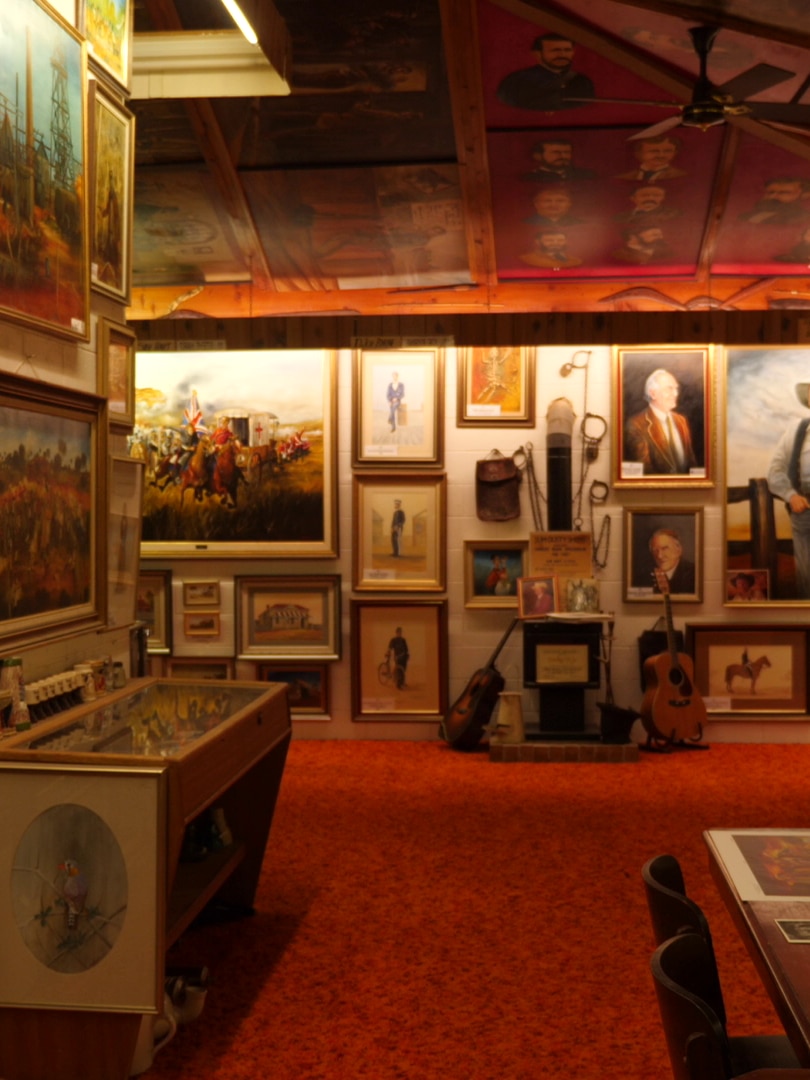On a quiet street behind a very ordinary-looking cream brick veneer an art gallery is hidden in the South Australian countryside.
The orange and red shag carpet is untouched from the 1970s when Frank Harding built his personal gallery and studio here.
It’s not far from Renmark’s main road and a stone’s throw from the Murray River, which inspired the police detective-turned-professional artist’s very first painting.
“Dad put his life into this place,” his daughter Megan Harding said.
Harding was born in 1935 in the small, rural Victorian town of Werrimull, halfway between Mildura and Renmark.
He worked in a shearing shed after school and then joined the South Australian Police and eventually became a detective with the criminal investigation branch.
Harding worked in regional and remote towns across the state and met his wife-to-be, Renmark local Nan, at a friend’s 21st birthday party.
The pair settled in Renmark and raised three girls.
“Love blossomed from there,” Ms Harding said.
“Dad was a very soft, loving person.
“He loved his three girls so much and he spoiled us rotten.”
Anything for anyone
Harding never had any formal art education but was stirred to create art while he was still working with the police.
“Dad did caricatures for sale, paintings for sale,” Ms Harding said.
“Anything that anyone came to the door wanting, he would do.
“He taught a paraplegic person how to paint with his mouth.”
Harding resigned from the police force in 1975 after 19 years of service and started making a living solely through his art.
But something that remains a mystery today is where his skill came from.
“Dad did some Pro Hart-style paintings and much later he found out they were distant cousins,” Ms Harding said.
“When Pro Hart died, a painting they made together fell off the wall.
“The nail was still in the wall and the string was still connected to the painting. Freaky.”
Priceless collection
At the age of 40, Harding built his gallery and studio and filled it with thousands of artworks to sell and exhibit in Australia, the United Kingdom and United States.
“We had an exhibition in London in 1977 and he was a bit concerned the English couldn’t relate to his style,” Ms Harding said.
“It sold out in the first five minutes — we were very surprised.”
Harding used oil paints, watercolour, pen, ink, and over the course of five years studied and perfected egg tempera like the great painters before him.
He was entirely self-taught and was inspired to capture the people of country Australia and the land they lived on.
“He loved bushrangers, because growing up as a child he’d always hear their stories,” Ms Harding said.
“Dad was thinking, ‘Well, the gallery walls are all full. It’s time we did something about the ceiling.'”
Harding meticulously crafted a series of paintings detailing Royal Australian Air Force pilots and their planes during actual events in World War II.
He corroborated his artwork with diary entries and records until the pieces were perfect and each was been signed by the pilot.
“The collection is priceless,” Ms Harding said.
A hidden treasure
Harding died in 1990 at the age of 55 and his gallery and studio remain as they were then.
His last piece, a depiction of a WWII horsemen, hangs unfinished, his paints and brushes undisturbed.
Architect, cultural historian and curator Derham Groves said galleries like Harding’s were uncommon.
“I think these house museums are very interesting, because they’re another kind of biography or autobiography in a way,” he said.
“This is the place where the artist lived and worked and it’s worth supporting.”
At the moment Harding’s unassuming gallery is only open by appointment or on a rare open day.
Ms Harding is looking for community support to open the gallery more often and those lucky enough to have seen it are spreading the word.
Visitor Alex Jones said the collection was “diehard Australian”.
“It’s a thing of beauty that shouldn’t be really closed up and hidden,” he said.
“It should be open for people to see.”
Renmark artist Colleen Bernadette Munday described Frank’s work as “brilliant”.
“It’s a shame he died,” she said.
“I see that he’s painted from his soul.”
Harding’s work was admired by about 80 people at a recent open day — the biggest group Ms Harding has welcomed in years.
She said it could be the momentum needed to keep her dad’s colourful life on display.
“It’s a lot of hard work, but I’m determined to keep it going in honour of my father,” she said.
“It will remain here for as long as I can possibly keep it going.”
Get our local newsletter, delivered free each Tuesday




